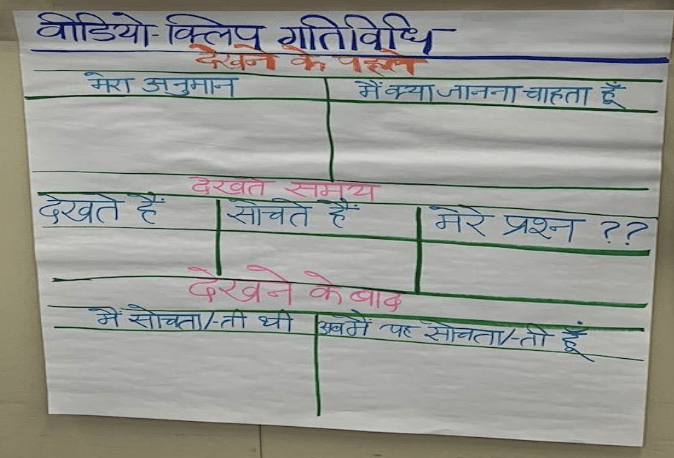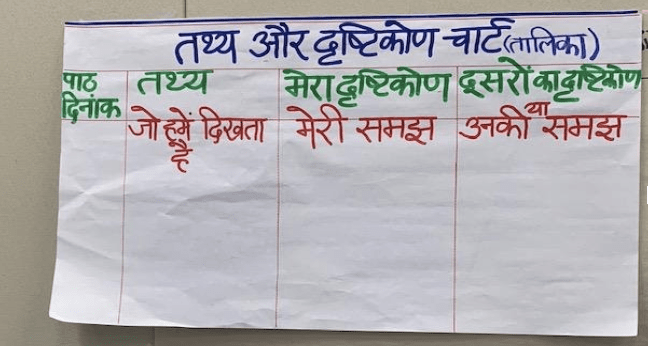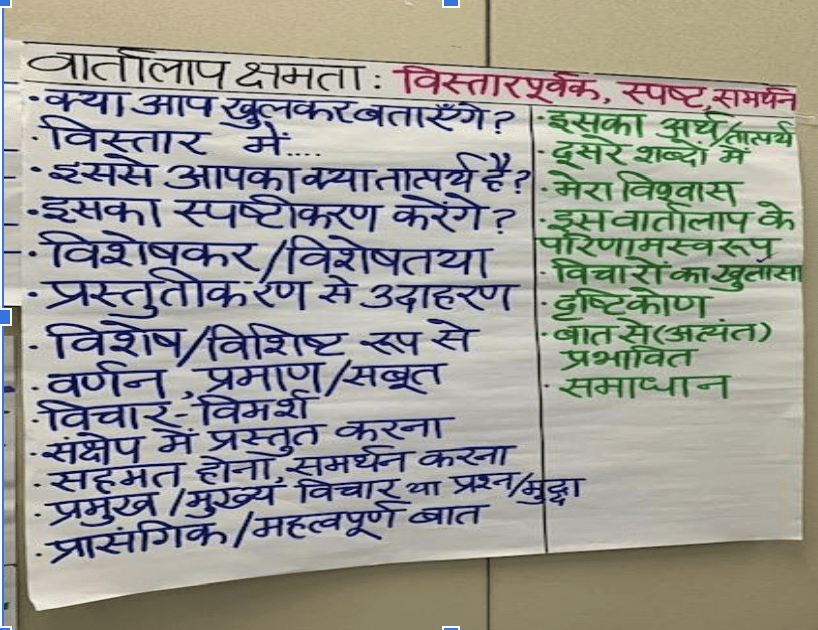Lesson designed by Bhavya Singh Lesson 1
Target Proficiency: Advance Mid-High
Time: 3×75 min
Students: HLL/ FLL
Age: College level
1. Objectives: Students will be able to:
- Understand & analyze underlying principles of Ashtanga yoga and Yogic philosophy of Suryanamaskaar. (Interpretive)
- Investigate & exchange information related to Suryanamaskaar and its effects as positive health benefits for overall mind & body wellness. (Interpersonal)
- Complete provided Info graphics and charts to demonstrate topic specific knowledge. (Interpretive)
- During an online tele collaboration with partner schools, student exchange and learn success stories of Ashtanga vinyasa yoga & Suryanamaskaar practitioners and leverage it to promote holistic standpoint of Ashtanga yoga. (Interpersonal)
- Deliver a persuasive presentational speech, describing health & fitness benefits of Ashtanga vinyasa yoga (Suryanamaskaar) at a community based Yuva diwas-event on January 12th on the occasion of Swami Vivekananda Jayanti. (Presentational)
2. Info graphics, Charts and rubrics used:
- 5w’s & H chart
- Facts & opinion chart
- Opinion writing graphic organizer
- Paragraph planner graphic organizer
- OREO persuasive writing graphic organizer
- Vocabulary building chart: Vocabulary word spinner
- Self and peer evaluation rubric
- PBL Works- Project work report: Individual
- Peer feedback form: informative oral presentation
3. Language structures:
- Imperative forms: आप, करिए, कीजिए, धन्यवाद, निवेदन करती हूँ, आमंत्रित करती हूँ, आग्रह करती हूँ, कृपया ध्यान दें
- Conditional (state of being) यदि मैं आपके स्थान पर होती/ होता—–तो होता/होती (action)यदि आप —-करें तो ——– करता /करती
- Formation of Adverbs from adjectives: विशेष रूप से, कृपया, सम्भवत:
- Conjunction: तथा, एवं, किंतु, परंतु, अथवा, व, अपितु (negative clause)
- Reflexive pronoun: स्वंम, अपना
- प्रशासनिक शब्दावली/ official vocabulary- संक्षिप्त, उपस्थित, अतिथिगन, आभाव, स्पष्ट, पूर्ण विश्वास, समावेशन, वर्जित, निषेध, आयोजन करना, प्रतिकूल, योगदान, सुविधा, परिषद्, आचरण, मौलिक,
- Absolutive expression: मुझे ये जान कर अति हर्ष हुआ,
- Prefixation: अनेक, अनदेखा, अंतर्मन, उन्नति, दुष्प्रभाव, के अनुसार, परिचित, प्रबंध, प्रतिदिन, प्रोत्साहन, प्रगति, विदेश, संस्थान
- Adjective formation with इक: दैनिक, औध्योगिक, प्रादेशिक, सांस्कृतिक, धार्मिक, श्रीमान
4. Real World Performance task:
- On Januray 12th on the occasion of Swami Vivekanand Jayanti, students as Wellness professionals at Yuva diwas saamuhik suryanamaskaar community event give a speech introducing Ashtanga yoga and the benefits of Suryanamaskaar
- During their public speaking students as Yoga wellness professionals (a) share various success stories of Ashtanga yoga practitioners, (b) convince and motivate wellness enthusiasts to join their Ayushmaan Yojna, (c) explain the lifestyle changes needed to improve health, (d) describe the global holistic wellness community and how expanding wellness networks leads to learning and growing.
5C & 3Ps of World language teaching standards:
- Yoga principles, philosophy, and techniques. (Culture)
- Study of Yoga as field of science, arts and Ancient India historical significance. (Connection)
- Interacting with native speakers and specialists in TL. (Communication)
- Yoga community and Hindi speech community (Community)
- Intercultural competence/ project based language learning: Ayushmaan Yojna
- Product: Yoga asana live demo using position terms and asana posters, Practice: Yoga techniques, Perspective: Yoga principles.
5. Resources:
- https://hindi.webdunia.com/dhyan-yoga/12-powerful-yoga-postures-116062000052_1.html
- https://youtu.be/vp0IPmdKx2I
- https://medium.com/@sadhakanshit/योग–व–अष्टांग–योग–क्या–है–इसके–अंगों–के–क्या–अर्थ–हैं–इसकी–क्या–महत्ता–है-4c84debf1209
6. Materials: Indian Initiatives: 
- https://youtu.be/HXGyT_llUKg
- https://youtu.be/bJvAb7KpKd0
- https://youtu.be/BtWEDncshqI
- https://youtu.be/tL79w6FtjuA
- https://youtu.be/q1bFdPI5vOU
Success stories:
6. Learning Scenarios:
Pre activity: Interpretive
- As part of the flipped classroom technique, students view selected resources on Ashtanga yoga and Suryanamaskaar. They complete a facts & opinion chart, 5W’s & H chart and video clip activity chart with information from the given resources. (PC: STARTALK Kean Student program)
- Students also fill vocabulary word spinner chart with new words and display it on VOCABULARY WALL for class viewing during gallery walk.

- इसे बनाओ
- समानार्थी शब्द दें
- विलोम/ विपरीतार्थक शब्द दें
- वाक्य बनायें
- शब्द भेद
Interpersonal:
- Jigsaw: Students placed in new groups share their individual facts and perspective charts. They negotiate and develop a common chart including the most important information about Ashtanga yoga, Suryanamaskaar and the effects on wellbeing.
- Students use discussion questionnaire during in class face-to-face interpersonal activities and during online tele-collaboration sessions with students from partner schools to get better insight on the discussion topics and information related to new government and non government initiatives taken towards adopting holistic health approach both at national and international levels.
- Students participate in a gallery walk (vocabulary wall) and engage in at least any one activity mentioned on vocabulary spinning wheel to build appropriate vocabulary related to the lesson topic and display their responses on post-its.
- Students participate in self and peer evaluation using rubrics, e.g. [gview file=”https://bpb-us-e1.wpmucdn.com/wp.nyu.edu/dist/e/3394/files/2020/01/PBLWorks-6-12-Collaboration-Rubric-Non-CCSS.pdf”] or [gview file=”https://bpb-us-e1.wpmucdn.com/wp.nyu.edu/dist/e/3394/files/2020/01/PBLWorks-9-12-Presentation-Rubric-Non-CCSS.pdf”]
- The give feedback using the following sentences:
- मेरा एक प्रश्न हैं —-
- मैंने ग़ौर किया है —–
- मैं सोचता/सोचती हूँ —–
- मैं आपसे सहमत हूँ क्यूँकि —–
- मैं इसे अब अलग तरह से देख सकता/सकती हूँ क्यूँकि ——
- मैं जोड़ना चाहूँगा/चाहूँगी —–
- Students update their charts with new information and collaborate by sharing completed charts with their parent student group to conduct and initiate further topic relevant-discussions.
They will include following topics and complete OREO persuasive writing graphic organizer and Paragraph planner.
OREO persuasive writing graphic organizer-
- विचार
- कारण
- उदाहरण
- विचार
Paragraph planner:
- विषय
- विषय वाक्य / मुख्य विचार
- विवरण
- समापन वाक्य
Presentational:
- Students draft final speech for community based Yuva diwas event on January 12th on the occasion of Swami Vivekananda Jayanti, describing the importance and health benefits of Ashtang Yoga and Practice of Surya namaskar.
- Students use speech rubric (peer feedback form: informative oral presentation) & PBL individual rubric ([gview file=”https://bpb-us-e1.wpmucdn.com/wp.nyu.edu/dist/e/3394/files/2020/01/PBLworks-Project-Work-Report-Individual.pdf”]) and effectively consolidate final collected data to cohesively present on the target specific topics with logical reasoning and examples to persuade and assure suggested solutions by adopting Ashtanga yoga.
- Students participate in speech rehearsal and incorporate teacher and peer feedback to improve their dialogue delivery, public speaking skills and speech content for final oral presentation on the day of event.
